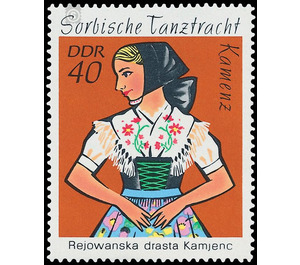Commemorative stamp series - Germany / German Democratic Republic 1971 - 40 Pfennig
Theme: Art & Culture
| Country | Germany / German Democratic Republic |
| Issue Date | 1971 |
| Face Value | 40.00 |
| Color | multi-colored brown |
| Perforation | K 13 1/2 |
| Printing Type | offset |
| Stamp Type | Postage stamp |
| Item Type | Stamp |
| Chronological Issue Number | 1413 |
| Chronological Chapter | GER-DDR |
| SID | 845137 |
| In 20 Wishlists | |
Sorbian Dance Costumes The Ministry of Posts and Telecommunications of the German Democratic Republic issues four multicolored special postage stamps with pictures of Sorbian dance costumes. Sorbische Tanztrachten Today's Sorbian costumes are remnants of formerly closed costume landscapes. Part of the female rural population of the middle and older generation still wears traditional costumes here in their daily lives. The costume of the men has already been filed in the last century, only some of its elements have been preserved to the present day. The bilingual circles of the districts of Dresden and Cottbus still have four different Sorbian costumes. Each is characterized by a variety of functional and age-related variants. Among them, especially the festive costumes are distinguished by their great wealth of forms, colors and folk art design. The Sorbian folk costumes document the creative power of the working people as well as the past as well as the present. In continuation of the 1968 published series Sorbian Festtrachten present special postage stamps represent the festive dancing costume of the girls dar. This is characterized by a special richness of color costume is created on special occasions by the female youth, even if she is not one of the permanent costume bearers. Sorbian folk art collectives like to use this costume for their youthful freshness as a stage costume. The costume of the Catholic Sorbs - Kamenz (40-pfennig value) The circulation area of this costume coincides with the boundaries of the Sorbian-Catholic parish of Upper Lusatia. Its center lies in the fertile area of the monastery Marienstern and the place Crostwitz in the circle Kamenz. The more favorable economic conditions allowed the local population better living conditions than the inhabitants of the heathlands. Therefore, in their costume more precious industrially manufactured fabrics could be processed. As a result, these clothes in shape and color was heavily exposed to fashion influences. In variants, this costume is just as varied as the others. For special occasions (church festivals, occasional weddings) the festive costumes of all generations in their original function boundness still created.


